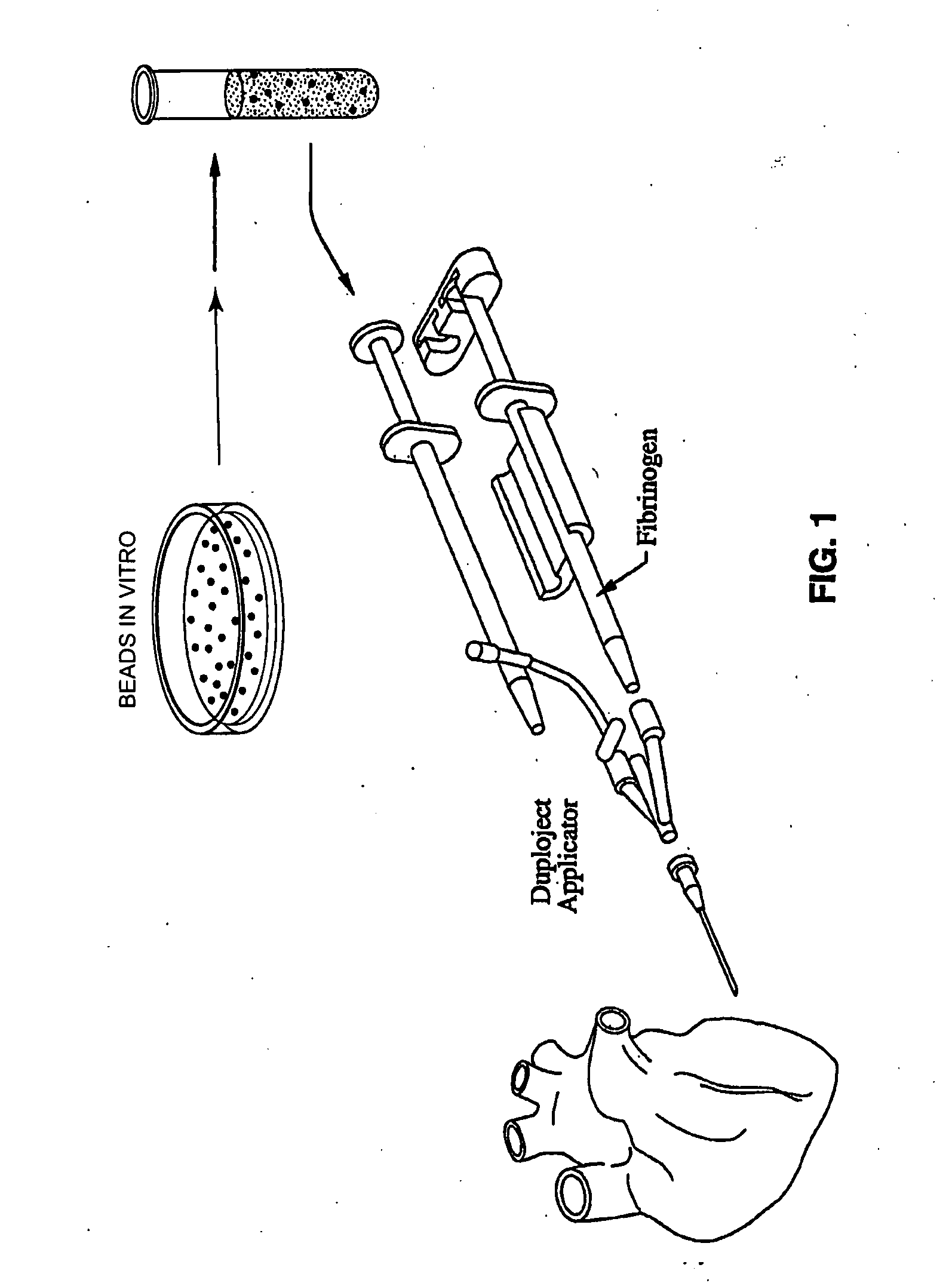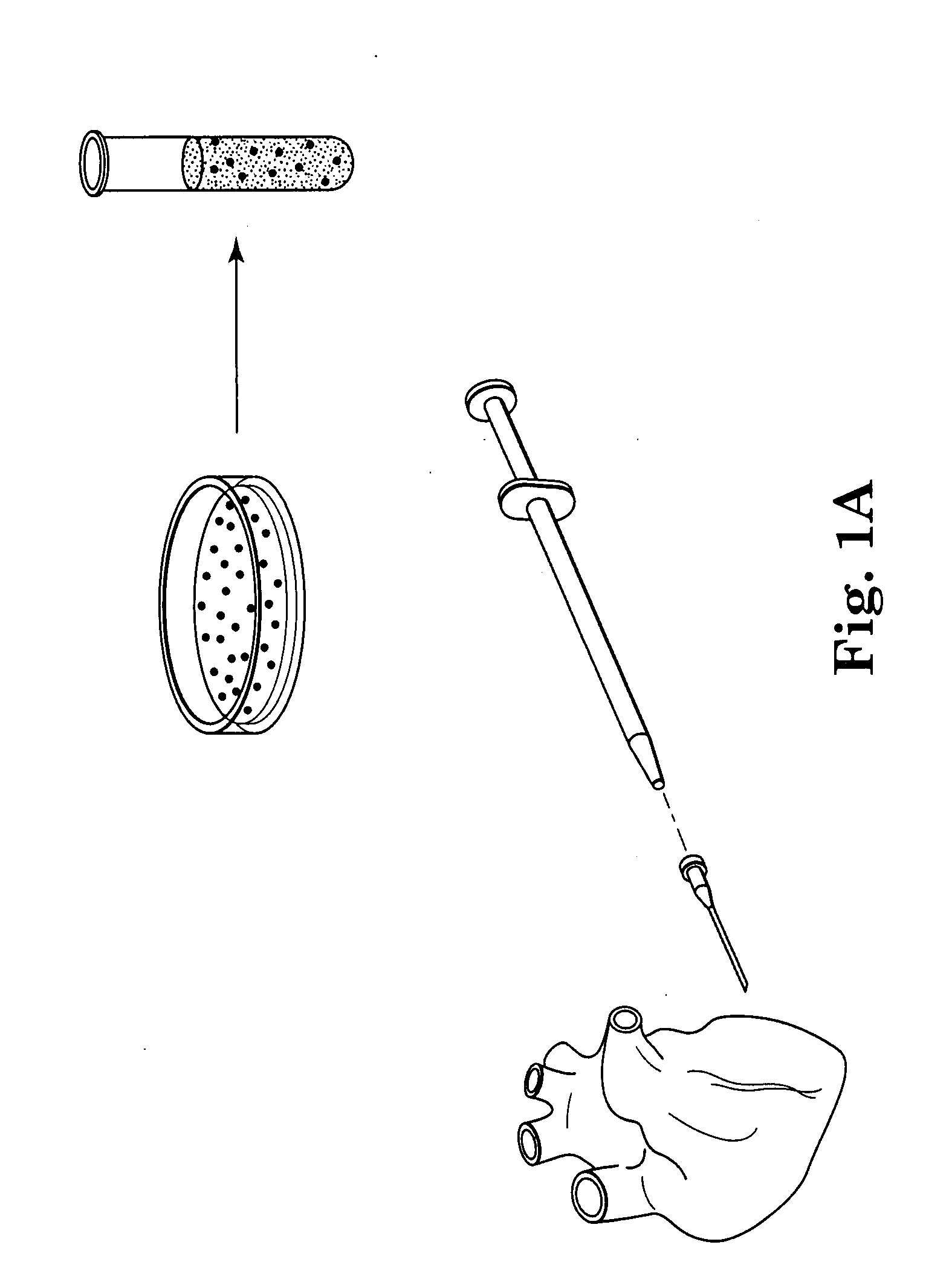Methods and apparatus for using polymer-based beads and hydrogels for cardiac applications
a technology of polymer-based beads and hydrogels, which is applied in the direction of angiogenin, prosthesis, drug compositions, etc., can solve the problems of significantly reducing global cardiac function, increasing wall stress in the remaining viable myocardium,
- Summary
- Abstract
- Description
- Claims
- Application Information
AI Technical Summary
Benefits of technology
Problems solved by technology
Method used
Image
Examples
example 1
[0059] In the first example, alginate was modified with the GRGDY peptide in solution to create a homogeneously modified material. The chemistry was optimized for a peptide density of 1 mg GRGDY per gram alginate as it is 2.5 orders of magnitude greater than the minimal RGD ligand spacing determined necessary for cell attachment when extrapolated to three-dimensional space (calculations based on a body centered cubic unit cell). Alginate chemistry was performed in 1% (v / v) alginate solutions in 0.1 M MES buffer at varying pH (6.0-7.5) and NaCl concentrations (0.0-0.7 M) for 12 or 20 hours. Sulfo-NHS was dissolved in the alginate solution at a ratio of 1:2 to EDC, and EDC was next added as a percentage of uronic acids available for reaction (0-50%). The GRGDY peptide was added after 5 min with 125I-GRGDY as a tracer molecule (activities of 2-5 μCi per reaction). The alginate product was purified by dialysis (3500 MWCO) against ddH2O for four days and lyophilized until dried. The resu...
example 2
[0060] In the second example, pre-formed hydrogels were modified with the GRGDY peptide using similar chemistries. Calcium cross-linked alginate hydrogels were prepared from 2% (v / v) alginate solutions in ddH2O containing 0.2% (w / v) Na(PO4)6 (Alfa, Ward Hill, Mass.). Calcium sulfate was added to alginate in 50 ml centrifuge tubes as a water-based slurry at 0.41 g CaSO4 / ml ddH2O, with 0.2 ml of the slurry added for every 5 ml of the 2% alginate solution to be gelled. The gelling solution was shaken rapidly and cast between parallel glass plates with 2 mm spacers to prepare gel films. Hydrogel disks were punched out of the film with a hole-punch (McMaster-Carr, Chicago, Ill.) for modification of the hydrogel. The hydrogel disks were derivatized with RGD using un-buffered EDC chemistry in ddH2O with sulfo-NHS as the co-reactant. Sulfo-NHS and EDC were added to 40 ml ddH2O at the same ratios as modification Example 1, followed by addition of the GRGDY peptide. Example 2 reactions were p...
experiment 1
Effects of GRGDSP on Human Umbilical Endothelial Vein Cells (HUVEC) on Proliferation.
[0112] In one in-vitro experiment, human umbilical vein endothelial cells (HUVEC) were utilized over a 10 day gestation period to demonstrate this effect. In this study, GRGDSP peptide material was covalently attached to high molecular weight M-type alginate (MW 297,000) in a ratio of 12 peptides per alginate molecule. HUVEC cells were added to the alginate solution and the solution was caused to gel by addition of 102 millimolar CaCl2. HUVEC cells were also added to a negative control high molecular weight alginate solution without peptide attachment and caused to gel via addition of calcium chloride as before. Both gels were measured for density at day one via an optical absorption measurement at 490 nanometers and again at day 10. The negative control alginate w / o peptide showed a marginal increase in absorption from 0.4 to approximately 0.42 absorption units at day 10 indicating a small increase...
PUM
| Property | Measurement | Unit |
|---|---|---|
| mean diameter | aaaaa | aaaaa |
| molecular weight distribution | aaaaa | aaaaa |
| molecular weight distribution | aaaaa | aaaaa |
Abstract
Description
Claims
Application Information
 Login to View More
Login to View More - R&D
- Intellectual Property
- Life Sciences
- Materials
- Tech Scout
- Unparalleled Data Quality
- Higher Quality Content
- 60% Fewer Hallucinations
Browse by: Latest US Patents, China's latest patents, Technical Efficacy Thesaurus, Application Domain, Technology Topic, Popular Technical Reports.
© 2025 PatSnap. All rights reserved.Legal|Privacy policy|Modern Slavery Act Transparency Statement|Sitemap|About US| Contact US: help@patsnap.com



